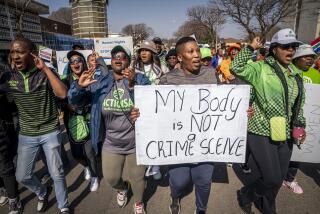Haiti alley tries to take matters in hand
Moustang Brisson is in charge as a founding member of the executive board of the Delmas 36 Committee, representing several blocks’ worth of homeless, destitute earthquake survivors.
Notebook in hand, he has taken down in careful cursive the names of 389 residents at 36 Delmas Street, all in need of food, water and tents.
“If we waited for the Haitian government to help, nou grangou,” Brisson said Thursday, using a Creole expression meaning they’d starve to death.
Across Port-au-Prince, block by block, Haitians are arranging themselves into subsets within the chaos around them. Seizing upon a centuries-long tradition of the most basic grass-roots community organizing, they have set up sort of neighborhood watch committees meant to facilitate the distribution of aid and maintain security.
Whether the international aid groups that are pouring in to Haiti seize upon this structure remains to be seen. Much of the distribution thus far has been haphazard and spotty, leaving Haitians dangerously frustrated at what they see as the slow pace of desperately needed help.
There is a Haitian propensity to organize at the margin of formal authority that dates to 18th century slavery times, said William G. O’Neill, an expert on Haiti at the New York-based Social Science Research Council.
“It’s an old Haitian tradition,” he said in a telephone interview. “Haiti is not so much a failed state as a phantom state. Haitians are used to having very little services. They see the state never comes, so they must do it themselves.”
Richard Coles, an apparel industry magnate, said the realization that many Haitians were on their own, burying the dead and mounting rescue operations, inspired business leaders to act with their own set of initiatives to restore basic services and assume other duties.
The attempts to do for themselves are evident along Delmas Street, a devastated thoroughfare that climbs through the capital. Dozens of committees have been formed.
At Delmas 36, as at most committee sites, members have draped a white sheet at the entryway to make their case. Weighted down by empty soda bottles, the sheet is inscribed with a plea, written, tellingly, not in French or Creole, but in English. “We need help please.”
The people represented by the committee live in an alleyway of houses that juts off Delmas Street several blocks all the way to a river. It is a rocky dirt road with tidy one- and two-story houses that have small front yards. This is Haiti’s middle class. They are not the abjectly poor who are hoarded into makeshift tent cities downtown, nor are they the wealthy who can largely escape the deprivations.
Still, they are sleeping in the roadway, under tarps they’ve tied to still-standing fences to shield them from the intense sun during the day and the potential nighttime rain. They are either afraid to reenter damaged homes, amid frequent aftershocks, or have homes that have collapsed.
Collectively, they decided to form the committee to help themselves deal with the aftermath of the terrifying magnitude 7.0 earthquake of Jan. 12.
“We all agreed that forming a committee was the best way to get help,” said Brisson, a pair of headphones around his neck, connected to nothing. “We did it, but so far nothing.”
The committee members dispatched envoys to the radio stations and the mayor’s office to put out word of what they needed: water, tents, toilet paper, portable toilets. They took up a collection to pay for gasoline to get two injured people, one a baby with a broken arm, to the hospital. They designated officers on the executive board to take charge of security, food, sanitation -- even public relations.
The security team placed pieces of metal fencing alongside roads to contain the neighbors. Every night, two people monitor the entryway to the alley to keep out intruders. Residents are especially worried about the several thousand prisoners who escaped jails during the earthquake.
“They could come at night while we sleep and rape the women,” said Brisson, an architect by profession, living with his mother and caring for two of his sister’s children. “Our weapons are bottles and rocks and sticks.”
Eight people were killed in this neighborhood during the earthquake, compared with the estimated tens of thousands all told. Still, the area was devastated. Residents make forays periodically in search of food.
The committee may be well organized -- Brisson keeps meticulous notes of each officer’s assignment and the talking points of what the neighborhood needs -- but it has little to show for its efforts.
As Brisson and a visitor walked the length of the alley, a group of women sitting in the road under a tarp mumbled that the committee hierarchy was keeping the aid for itself. Asked about it later, they demurred, saying they only knew that they hadn’t benefited.
“They do give us security,” said Malmede Tanis, a 35-year-old mother of two boys, ages 13 and 14. “But I haven’t seen any food.”
Tanis led a reporter through a concrete warren to her house, which faced the river and had fallen onto itself. On the afternoon of the quake, she grabbed a couple of pots and pans and her two children and is now in the roadway.
The neighborhood is not in the worst of conditions. But tensions simmer. It is chilly at night, and there is no way to keep the children warm.
“This neighborhood,” Brisson said, “like every neighborhood, is abandoned.”
More to Read
Start your day right
Sign up for Essential California for news, features and recommendations from the L.A. Times and beyond in your inbox six days a week.
You may occasionally receive promotional content from the Los Angeles Times.







